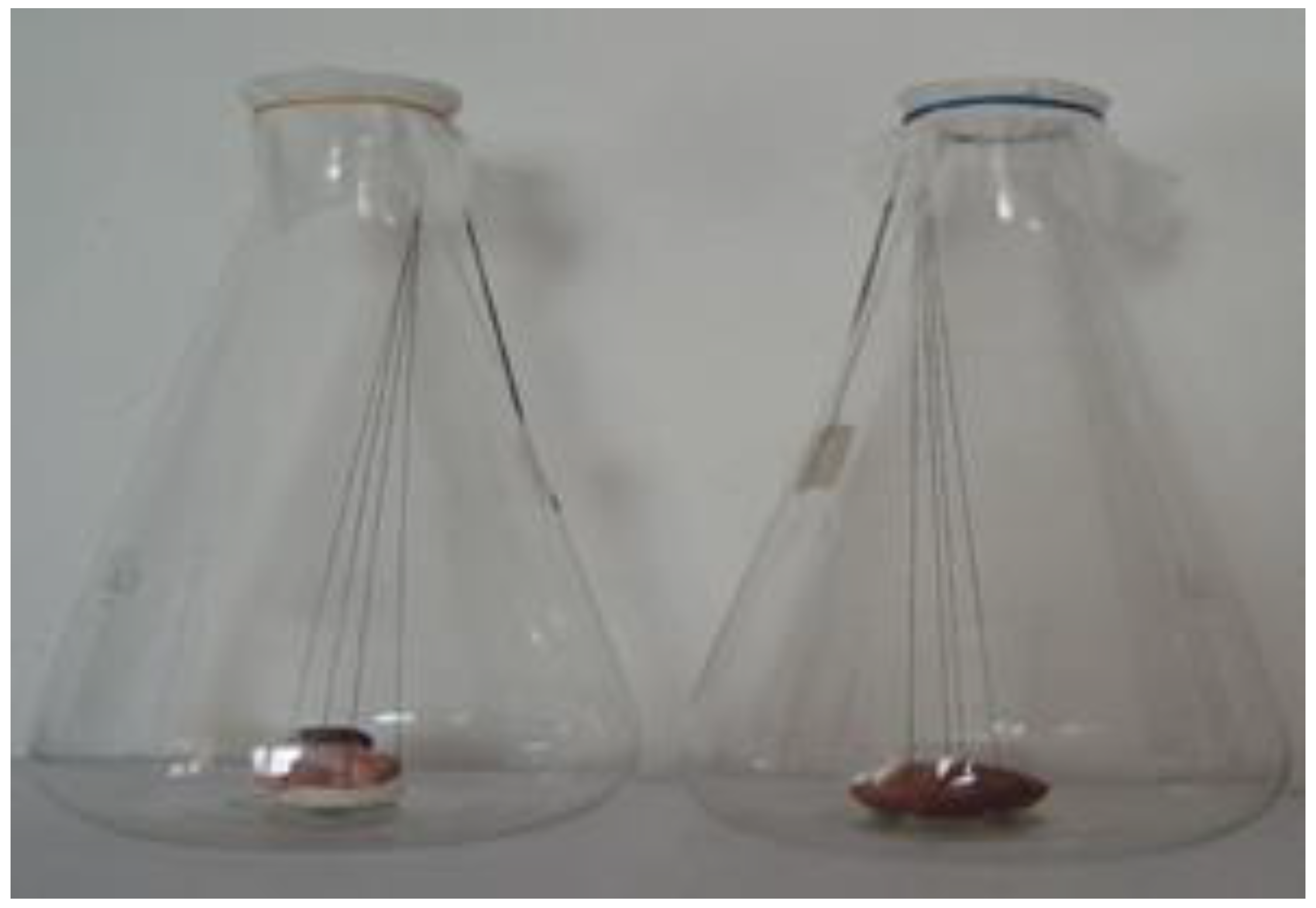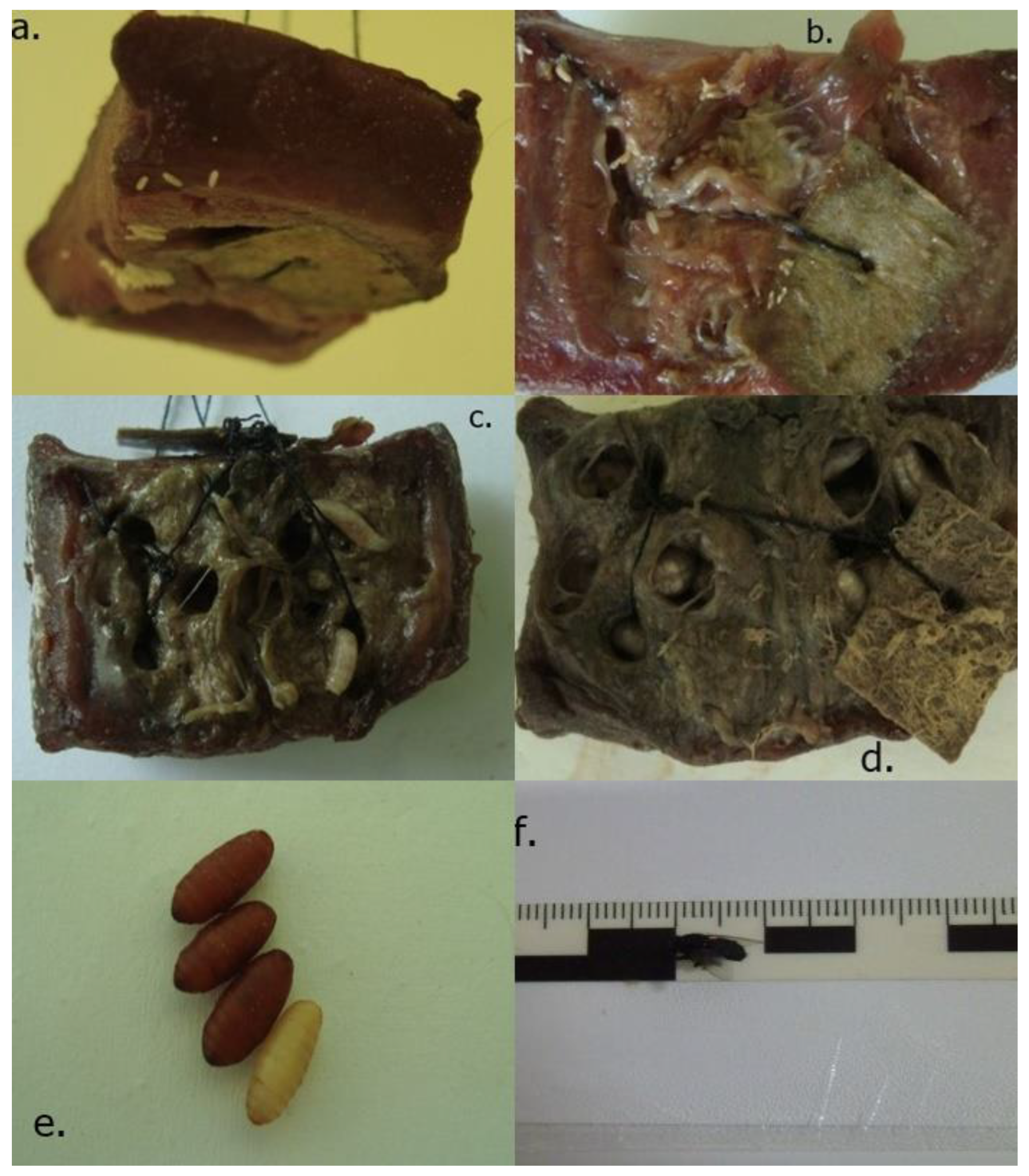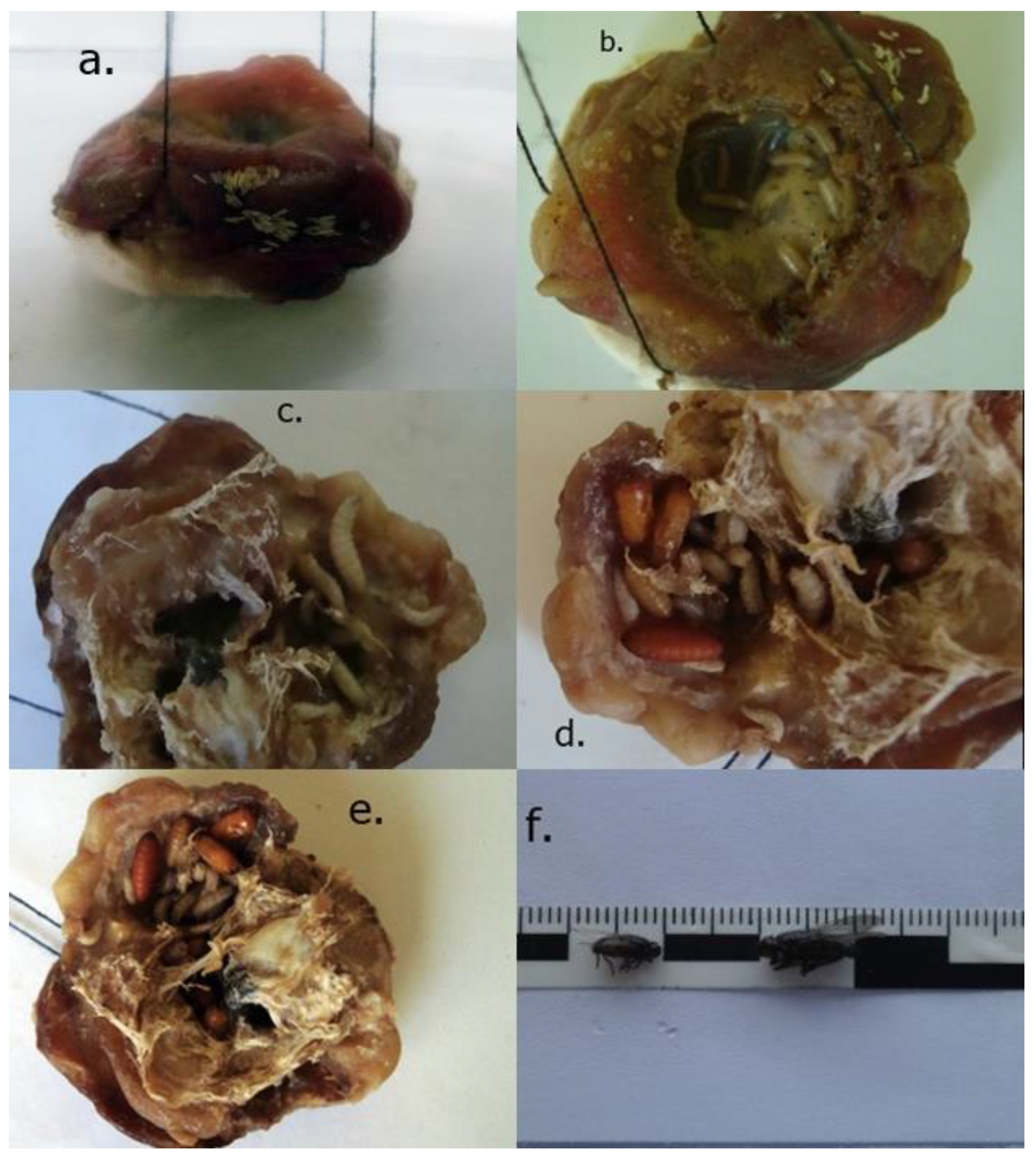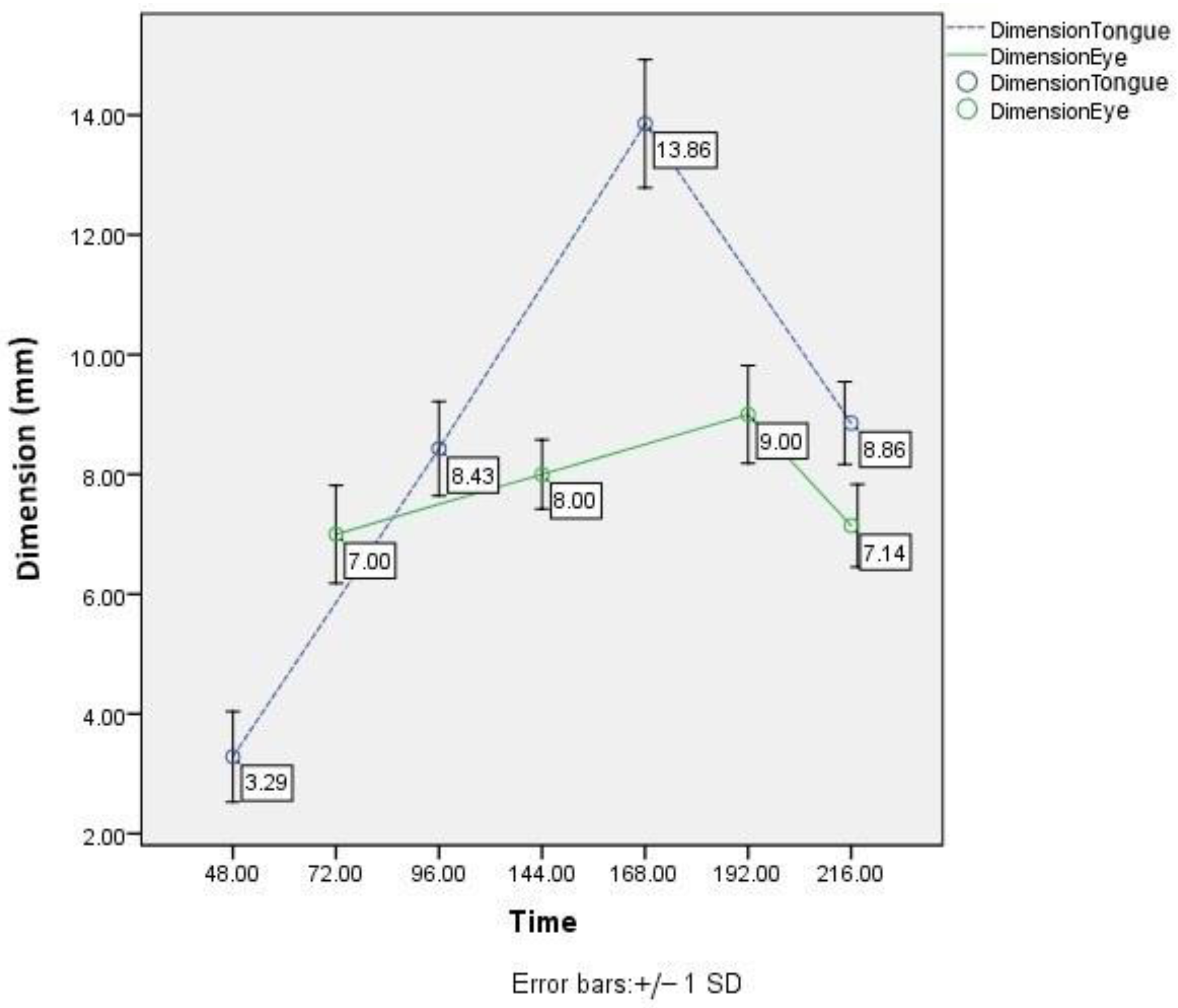Preliminary Study on the Larval Development of Calliphora vicina (Diptera: Calliphoridae) on Different Types of Substrates Used as Reference in Forensic Entomology
Abstract
1. Introduction
2. Materials and Methods
3. Results and Discussions
3.1. Characteristics of the Development of Caliphora vicina on Different Substrates
3.2. Pig Tongue and Eye
4. Conclusions
Author Contributions
Funding
Institutional Review Board Statement
Informed Consent Statement
Data Availability Statement
Conflicts of Interest
References
- Matei, G. Importanța entomologiei în investigația criminalistică. Rev. Română Crim. 2005, 6, 14–16. [Google Scholar]
- Gennard, E.D. Forensic Entomology: An Introduction; Wiley and Sons: West Sussex, UK, 2007. [Google Scholar]
- Gunn, A. Essential Forensic Biology, 2nd ed.; Wiley and Sons: Liverpool, UK, 2009. [Google Scholar]
- Thompson, C.R.; Brogan, R.S.; Scheifele, L.Z.; Rivers, D.B. Bacterial interactions with necrophagous flies. Ann. Entomol. Soc. Am. 2013, 106, 799–808. [Google Scholar] [CrossRef]
- Leccese, A.M. Insects as forensic indicators: Methodological aspects. Anil Aggarwal’s Internet J. Forensic Med. Toxicol. 2004, 5, 26–32. [Google Scholar]
- Crooks, E.R.; Bulling, M.T.; Barnes, K.M. Microbial effects on the development of forensically important blow fly species. Forensic Sci. Int. 2016, 266, 185–190. [Google Scholar] [CrossRef]
- Amendt, J.; Richards, C.S.; Campobasso, C.P.; Zehner, R.; Hall, M.J.R. Forensic entomology: Applications and limitations. Forensic Sci. Med. Pathol. 2011, 7, 379–392. [Google Scholar] [CrossRef] [PubMed]
- Hall, M.J.R. The Relationship between Research and Casework in Forensic Entomology. Insects 2021, 12, 174. [Google Scholar] [CrossRef]
- Rodriguez, W.C.; Bass, W.M. Insect Activity and its Relationship to Decay Rates of Human Cadavers in East Tennessee. J. Forensic Sci. 1983, 28, 423–432. [Google Scholar] [CrossRef]
- Greenberg, B. Flies as forensic indicators. J. Med. Entomol. 1991, 28, 565–577. [Google Scholar] [CrossRef]
- Vanin, S.; Gherardi, M.; Bugelli, V.; Di Paolo, M. Insects found on a human cadaver in central Italy including the blowfly Calliphora loewi (Diptera, Calliphoridae), a new species of forensic interest. Forensic Sci. Int. 2011, 207, e30–e33. [Google Scholar] [CrossRef]
- George, K.A.; Archer, M.S.; Toop, T. Abiotic environmental factors influencing blowfly colonization patterns in the field. Forensic Sci. Int. 2013, 229, 100–107. [Google Scholar] [CrossRef]
- Tomberlin, J.K.; Benbow, M.E. Forensic Entomology; CRC Press: Boca Raton, FL, USA; Taylor & Francis Group: Milton Park, UK, 2015. [Google Scholar]
- Barnes, K.M.; Grace, K.A.; Bulling, M. Nocturnal Oviposition Behavior of Forensically Important Diptera in Central England. J. Forensic Sci. 2015, 60, 1601–1604. [Google Scholar] [CrossRef] [PubMed]
- Verma, K.; Reject, P. Assessment of Post Mortem Interval, (PMI) from Forensic Entomotoxicological Studies of Larvae and Flies. Entomol. Ornithol. Herpetol. 2013, 2, 104–108. [Google Scholar]
- Kirkpatrick, R.S.; Olson, J.K. Nocturnal light and temperature influences on necrophagous, carrion-associating blowfly species (Diptera: Calliphoridae) of forensic importance in Central Texas. Southwest. Entomol. 2007, 32, 1601–1604. [Google Scholar] [CrossRef][Green Version]
- Tomberlin, J.K.; Crippen, T.L.; Tarone, A.M.; Singh, B.; Adams, K.; Rezenom, Y.H.; Benbow, M.E.; Flores, M.; Longnecker, M.; Pechal, J.L.; et al. Interkingdom responses of flies to bacteria mediated by fly physiology and bacterial quorum sensing. Anim. Behav. 2012, 84, 1449–1456. [Google Scholar] [CrossRef]
- Richards, C.S.; Rowlinson, C.C.; Cuttiford, L.; Grimsley, R.; Hall, M.J.R. Decomposed Liver has a significantly adverse effect on the development rate of the blowfly Calliphora vicina. Int. J. Leg. Med. 2013, 127, 259–262. [Google Scholar] [CrossRef] [PubMed][Green Version]
- Metcalf, J.L.; Xu, Z.Z.; Weiss, S.; Lax, S.; Van Treuren, W.; Hyde, E.R.; Song, S.J.; Amir, A.; Larsen, P.; Sangwan, N.; et al. Microbial community assembly and metabolic function during mammalian corpse decomposition. Science 2016, 351, 158–162. [Google Scholar] [CrossRef] [PubMed]
- Somerville, D.A. The Normal Flora of the Skin in Different Age Groups. Br. J. Dermatol. 1969, 81, 248–258. [Google Scholar] [CrossRef]
- Hau, T.C.; Hamzah, N.H.; Lian, H.H. Decomposition Process and Post Mortem Changes: Review. Sains Malays. 2014, 43, 1873–1882. [Google Scholar]
- Metcalf, J.L.; Parfrey, L.W.; Gonzalez, A.; Lauber, C.L.; Knights, D.; Ackermann, G.; Humphrey, G.C.; Gebert, M.J.; Van Treuren, W.; Berg-Lyons, D.; et al. A microbial clock provides an accurate estimate of the postmortem interval in a mouse model system. eLife 2013, 2, e01104. [Google Scholar] [CrossRef]
- Carter, D.O.; Yellowlees, D.; Tibbett, M. Temperature affects microbial decomposition of cadavers (Rattus rattus) in contrasting soils. Appl. Soil Ecol. 2008, 40, 129–137. [Google Scholar] [CrossRef]
- Janaway, R.C.; Percival, S.L.; Wilson, A.S. Decomposition of Human Remains. In Microbiology and Aging; Percival, S.L., Ed.; Springer: New York, NY, USA, 2009; pp. 313–334. [Google Scholar]
- Carter, D.O.; Metcalf, J.A.; Bibat, A.; Knight, R. Seasonal variation of post-mortem microbial communities. Forensic Sci. Med. Pathol. 2015, 11, 202–207. [Google Scholar] [CrossRef] [PubMed]
- Crisan, A.; Muresan, D. Clasa Insecte. In Manual de Entomologie Generală; Presa Universitara Clujană: Cluj-Napoca, Romania, 1999. [Google Scholar]
- Lehrer, Z.A. Fauna Republicii Socialiste Romania-Insecta: Diptera, Familia; Academiei Republicii Socialiste România: Bucuresti, Romania, 1972; Volume XI, p. 12. [Google Scholar]
- Iwasaki, S. Evolution of the structure and function of the vertebrate tongue. J. Anat. 2002, 201, 1–13. [Google Scholar] [CrossRef] [PubMed]
- Coțofan, V.; Hrițcu, V. Anatomia Animalelor Domestice. In Organologie; Orizonturi Universitare: Timișoara, Romania, 2007; Volume II, pp. 77–82. [Google Scholar]
- Pastea, E.; Cotofan, V.; Chitescu, S.; Miclea, M.; Cornelia, N.; Niculescu, V.; Radu, C.; Popovici, I.; Palicica, R. Anatomia Comparata o Animalelor Domestice; Didactica si Pedagocica: Bucuresti, Romania, 1985; Volume I, pp. 251–253. [Google Scholar]
- Donovan, S.E.; Hall, M.J.R.; Turner, B.D.; Moncrieff, C.B. Larval growth rates of the blowfly, Calliphora vicina, over a range of temperatures. Med. Vet. Entomol. 2006, 20, 106–114. [Google Scholar] [CrossRef] [PubMed]
- Hadjer-Kounouz, S.; Kamel, L. Development of Calliphora vicina (Robineau-Desvoid)(Diptera: Calliphoridae) under dif-ferent biotic and abiotic conditions. J. Entomol. Zool. Stud. 2017, 5, 683–691. [Google Scholar]
- Kaneshrajah, G.; Turner, B. Calliphora vicina larvae grow at different rates on different body tissues. Int. J. Leg. Med. 2004, 118, 242–244. [Google Scholar] [CrossRef]
- Bernhardt, V.; Schomerus, C.; Verhoff, M.A.; Amendt, J. Of pigs and men—Comparing the development of Calliphora vicina (Diptera: Calliphoridae) on human and porcine tissue. Int. J. Leg. Med. 2017, 131, 847–853. [Google Scholar] [CrossRef]
- Day, D.M.; Wallman, J.F. Influence of Substrate Tissue Type on Larval Growth in Calliphora augur and Lucilia cuprina (Diptera: Calliphoridae). J. Forensic Sci. 2006, 51, 657–663. [Google Scholar] [CrossRef]
- Niederegger, S.; Pastuszek, J.G. Preliminary studies of the influence of fluctuating temperatures on the development of various forensically relevant flies. Forensic Sci. Int. 2010, 199, 72–78. [Google Scholar] [CrossRef]
- Matuszewski, S.; Szafałowicz, M.; Grzywacz, A. Temperature-dependent appearance of forensically useful flies on carcasses. Int. J. Leg. Med. 2013, 128, 1013–1020. [Google Scholar] [CrossRef]
- Defilippo, F.; Bonilauri, M.S.P.; Dottori, M. Effect of Temperature on Six Different Developmental Landmarks within the Pupal Stage of the Forensically Important Blowfly Calliphora vicina (Robineau-Devoidy) (Diptera: Calliphoridae). Forensic Sci. Int. 2013, 58, 1554–1557. [Google Scholar]
- Priscilla, H.S. The spectral sensitivity of Calliphora maggots. J. Exp. Biol. 1961, 38, 237–248. [Google Scholar]
- Singh, D.; Bala, M. Studies on larval dispersal in two species of blowflies (Diptera: Calliphoridae). J. Forensic Res. 2010, 102, 2. [Google Scholar]
- Davies, L. Lifetime reproductive output of Calliphora vicina and Lucilia sericata in outdoor caged and field populations; flight vs. egg production? Med. Vet. Entomol. 2006, 20, 453–458. [Google Scholar] [CrossRef] [PubMed]
- Salanitro, L.B.; Massaccesi, A.C.; Urbisaglia, S.; Peria, M.E.; Centeno, N.D.; Chirino, M.G. Calliphora vicina (Diptera: Calliphoridae): Growth rates, body length differences, and implications for the minimum post-mortem interval estimation. Rev. Soc. Entomol. Argent. 2022, 81, 39–48. [Google Scholar] [CrossRef]
- Clark, K.; Evans, L.; Wall, R. Growth rates of the blowfly, Lucilia sericata, on different body tissues. Forensic Sci. Int. 2006, 156, 145–149. [Google Scholar] [CrossRef] [PubMed]
- Day, D.M.; Wallman, J.F. A comparison of frozen/thawed and fresh food substrates in development of Calliphora augur (Diptera: Calliphoridae) larvae. Int. J. Leg. Med. 2006, 120, 391–394. [Google Scholar] [CrossRef]
- Jones, T.H.; Turner, B.D. The effect of host spatial distribution on patterns of parasitism by Nasonia vitripennis. Èntomol. Exp. Appl. 1987, 44, 169–175. [Google Scholar] [CrossRef]
- King, P.E.; Askew, R.R.; Sanger, C. The detection of parasitized host by male of Nasonia vitripennis (Walker) (Hymenoptera: Pteromalidae) and some possible implications. Physiol. Entomol. 1969, 44, 85–90. [Google Scholar]
- Vinogradova, E.B.; Zinovjeva, K.B. Maternal induction on larval diapauses in the blowefly, Calliphora vicina. J. Insect Physiol. 1972, 18, 2401–2409. [Google Scholar] [CrossRef]
- Kalyanaraman, D.; Gadau, J.; Lammers, M. The generalist parasitoid Nasonia vitripennis shows more behavioural plasticity in host preference than its three specialist sister species. Ethology 2021, 127, 964–978. [Google Scholar] [CrossRef]
- Bates, L.N.; Wescott, D.J. Comparison of decomposition rates between autopsied and non-autopsied human remains. Forensic Sci. Int. 2016, 261, 93–100. [Google Scholar] [CrossRef] [PubMed]
- Frederickx, C.; Dekeirsschieter, J.; Verheggen, F.J.; Haubruge, E. Depth and type of substrate influence the ability of Nasonia vitripennis to locate a host. J. Insect Sci. 2014, 14, 58. [Google Scholar] [CrossRef] [PubMed][Green Version]





| Developmental Stage | Temperature (°C) | Time (Hours) | Dimensions Average (mm) | Standard Deviation | 95% Confidence Interval between Limits | |
|---|---|---|---|---|---|---|
| Inferior Limit (mm) | Superior Limit (mm) | |||||
| Eggs | 25 | - | - | - | ||
| Larva stage I | 25 | 48 | 3.29 | 0.75 | 2.59 | 3.98 |
| Larva stage II | 25 | 96 | 8.43 | 0.78 | 7.70 | 9.16 |
| Larva stage III | 25 | 168 | 13.85 | 1.06 | 12.86 | 14.84 |
| Pupa | 25 | 216 | 8.85 | 0.69 | 8.21 | 9.49 |
| Fly | 25 | 240 | Different | - | ||
| Developmental Stage | Temperature (°C) | Time (Hours) | Dimensions Average (mm) | Standard Deviation | 95% Confidence Interval between Limits | |
|---|---|---|---|---|---|---|
| Inferior Limit (mm) | Superior Limit (mm) | |||||
| Eggs | 25 | - | - | - | ||
| Larva stage I | 25 | 72 | 7.00 | 0.81 | 6.24 | 7.76 |
| Larva stage II | 25 | 144 | 8.00 | 0.57 | 7.47 | 8.53 |
| Larva stage III | 25 | 192 | 9.00 | 0.81 | 8.24 | 9.76 |
| Pupa | 25 | 216 | 7.14 | 0.69 | 6.50 | 7.78 |
| Fly | 25 | 264 | Different | - | ||
Publisher’s Note: MDPI stays neutral with regard to jurisdictional claims in published maps and institutional affiliations. |
© 2022 by the authors. Licensee MDPI, Basel, Switzerland. This article is an open access article distributed under the terms and conditions of the Creative Commons Attribution (CC BY) license (https://creativecommons.org/licenses/by/4.0/).
Share and Cite
, C.M.; Sandu, I.; Iliescu, D.B.; Forna, N.C.; Vasilache, V.; Sîrbu, V. Preliminary Study on the Larval Development of Calliphora vicina (Diptera: Calliphoridae) on Different Types of Substrates Used as Reference in Forensic Entomology. Appl. Sci. 2022, 12, 10907. https://doi.org/10.3390/app122110907
CM, Sandu I, Iliescu DB, Forna NC, Vasilache V, Sîrbu V. Preliminary Study on the Larval Development of Calliphora vicina (Diptera: Calliphoridae) on Different Types of Substrates Used as Reference in Forensic Entomology. Applied Sciences. 2022; 12(21):10907. https://doi.org/10.3390/app122110907
Chicago/Turabian Style(Amariei), Cristiana Manea, Ion Sandu, Diana Bulgaru Iliescu, Norina Consuela Forna, Viorica Vasilache, and Vasile Sîrbu. 2022. "Preliminary Study on the Larval Development of Calliphora vicina (Diptera: Calliphoridae) on Different Types of Substrates Used as Reference in Forensic Entomology" Applied Sciences 12, no. 21: 10907. https://doi.org/10.3390/app122110907
APA Style, C. M., Sandu, I., Iliescu, D. B., Forna, N. C., Vasilache, V., & Sîrbu, V. (2022). Preliminary Study on the Larval Development of Calliphora vicina (Diptera: Calliphoridae) on Different Types of Substrates Used as Reference in Forensic Entomology. Applied Sciences, 12(21), 10907. https://doi.org/10.3390/app122110907








